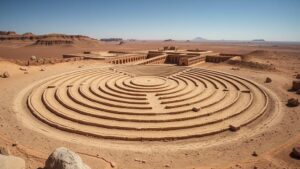Exploring the myths of Lemuria and its alleged connection to advanced human precursors.
Exploring the Myths of Lemuria and Its Alleged Connection to Advanced Human Precursors
The concept of Lemuria has fascinated scholars, mystics, and enthusiasts for over a century. Often dubbed a lost continent, the myth of Lemuria is intertwined with theories of ancient advanced civilizations and human precursors. This article delves into the origins of the Lemurian myth, its cultural significance, and the evidence–or lack thereof–that supports its existence and connection to humanitys distant past.
Origins of the Lemurian Myth
The term Lemuria was coined in the mid-19th century by zoologist Philip Sclater in a paper published in 1864. Sclater proposed the existence of a submerged landmass in the Indian Ocean to explain the distribution of lemurs, a species of primate. He noted that lemurs were primarily found in Madagascar and certain regions of Asia, suggesting that a land bridge might have connected these areas in earlier geological times.
In 1885, the concept was further popularized by the theosophical movement, particularly through the writings of Helena Blavatsky, who described Lemuria as a highly advanced civilization predating recorded history. According to Blavatsky, Lemurians were believed to possess superior spiritual and intellectual abilities, which contributed to their development as a precursor to modern humanity.
Cultural Interpretations and Influences
The myth of Lemuria has penetrated popular culture and various fields, transcending its origins in zoology and theosophy. It has influenced literature, spirituality, and even pseudoarchaeology. Novels such as James Hiltons “Lost Horizon” and films like “Avatar” have incorporated themes of lost civilizations reminiscent of Lemuria, embedding its mythos in public consciousness.
The notion of advanced precursors, often depicted as golden ages of humanity, is a recurring theme in various cultural narratives worldwide. This can be seen in:
- Atlantis, as mentioned by Plato, a civilization of unparalleled wisdom and technology.
- The ancient Egyptian belief in a lost city called Khémet, thought to be the birthplace of civilization.
- Mayan legends of a lost civilization akin to Lemuria, showcasing advanced astronomical knowledge.
Scientific Examination of Lemuria
Despite its captivating narrative, the scientific validity of Lemuria is often questioned. Geological and archaeological research has not provided concrete evidence of its existence. The field of plate tectonics, which gained prominence in the mid-20th century, explains many geological phenomena previously attributed to lost continents. For example, the distribution of flora and fauna is now understood through biogeographic principles rather than the existence of a land bridge like Lemuria.
Also, genetic studies have shown that the lemur population in Madagascar shares a common lineage with species from Africa and Asia, further dismissing the need for a lost continent.
Connection to Advanced Human Precursors
The idea of Lemuria as a home to advanced human precursors presents intriguing considerations about human evolution. Proponents of the Lemurian myth often cite aspects such as:
- Spiritual evolution and the development of psychic abilities.
- Technological advancements, such as crystal-powered technology.
- A global spiritual network originating from Lemurian wisdom.
But, these claims largely stem from spiritual beliefs rather than scientific evidence. Major anthropological studies indicate that civilizations have evolved independently across different regions, shaped by their environments rather than a singular advanced source. For example, the agricultural revolution occurred independently in places such as the Fertile Crescent, Mesoamerica, and East Asia around 10,000 years ago, highlighting humanitys diverse developmental paths.
Modern-Day Relevance
The allure of Lemuria persists today, often representing the human yearning for lost knowledge and spiritual enlightenment. myth serves as a metaphor for the potential within humanity for growth and enlightenment, something often explored in contemporary spirituality and self-help literature.
Plus, the fascination with lost civilizations speaks to broader themes in human history, like the quest for identity and the exploration of our cultural origins. By examining myths like Lemuria, we can reflect on our own narratives and the values we hold.
Actionable Takeaways
As we explore the myth of Lemuria and its alleged connection to advanced human precursors, consider the following:
- Engage with a variety of sources–historical, scientific, and cultural–to form a well-rounded understanding.
- Reflect on the ideas of lost knowledge and its implications for personal growth and development.
- Maintain a critical perspective, especially when exploring claims of advanced civilizations without substantial evidence.
To wrap up, the legend of Lemuria serves as both a captivating narrative and a cautionary tale about the intersection of science, mythology, and humanitys relentless search for meaning. Whether seen as a genuine part of our ancestral past or as a metaphor for human potential, Lemuria continues to inspire exploration and inquiry into the depths of our history.


